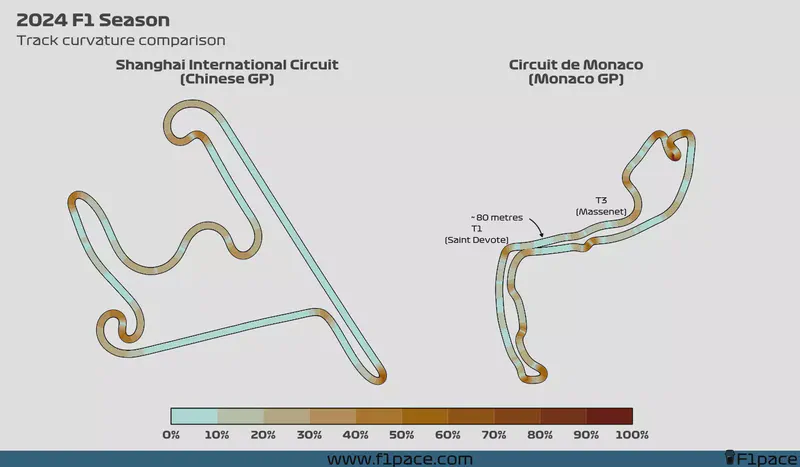Kevin Magnussen and Sergio Pérez were involved in a significant crash during the 2024 F1 Monaco GP. Magnussen’s left front tire touched Pérez’s right rear tire, causing the Mexican driver to spin out of control and hit a barrier.
While the stewards decided not to investigate the incident, many people disagreed. One argument I read on some F1 forums was that the accident occurred because Pérez didn’t leave enough space for Magnussen while on a straight. My first reaction was, “Wait a minute, what straight?”
Given that I already had some code to determine the curvature of a track, I decided to run an analysis to see if Monaco even had straights at all.
Analysis
Track curvature

I started by calculating the curvature of two tracks with very different characteristics: the Shanghai International Circuit and the Circuit de Monaco. The Chinese GP track, while featuring twisty sections, has two clearly defined long straights. Monaco, on the other hand, is extremely twisty and narrow, raising the question of whether it has any straights at all.
The range of the curvature scale goes from 0% (completely straight) to 100% (very twisty like the Monaco Hairpin curve).
My analysis shows that the Circuit de Monaco does have a few straights, but they are very short and scattered across the track. The “main straight” between T1 (Sainte Devote) and T3 (Massenet) contains four sections that could be considered completely straight (with less than 10% curvature), but these sections are not connected. The longest straight section between these corners is just 80 meters long, much shorter than the traditional straights found on most tracks. The rest of the track is similar, with only a few truly straight sections, most of which are less than 100 meters in length.
In comparison, the Shanghai International Circuit has two very long straights—one around 800 meters long and the longest at 1.4 km—along with several other shorter straight sections throughout the track.
Track curvature distribution

If we examine the distribution of track curvature, the stark difference between the two tracks becomes evident. Approximately 42% of the Shanghai International Circuit is considered to be relatively flat, while only 23% of Monaco’s GP track is straight.
The most interesting aspect of this analysis is that 36% of Monaco’s track is “slightly twisty,” with a curvature between 10% and 20%, and an additional 21.7% is even twistier, with a curvature between 20% and 30%. The Circuit de Monaco can be described generally as “curvy” or “twisty.” While it may not be filled with extreme curvature, a significant portion of the track exhibits a notable degree of it.
The crash
Any driver defending his position on a straight, and before any braking area, may use the full width of the track during his first move, provided no significant portion of the car attempting to pass is alongside his. For the avoidance of doubt, if any part of the front wing of the car attempting to pass is alongside the rear wheel of the car in front this will be deemed to be a ‘significant portion’.
While browsing F1 forums, I noticed several people referencing a previous technical directive published in 2014, which is not mentioned in the 2024 Formula One Sporting Regulations. The main point of this directive is that, during an overtake on a straight, the overtaking car is considered “significantly alongside” as long as its front wing overlaps the rear wheel of the car ahead.
However, these rules do not apply to overtakes while cornering, especially on the outside. New sporting guidelines are set to be published for the 2025 season, but some sources, such as F1’s new 2024 overtaking rules explained, indicate that the new guidelines state the overtaking car must have its front axle at least alongside the leading car’s front axle when overtaking on a turn. If this condition is not met, the trailing driver is not necessarily entitled to space.
So, did Magnussen make a move on a straight, or a corner? This is the critical question.
My conclusion
In my opinion, Monaco lacks any well-defined straights. While there are some straight sections on the track, they are too short to qualify as proper straights. Overtaking in Monaco requires extreme caution, with most of the responsibility falling on the chasing driver.
Given this, I don’t believe Magnussen was entitled to space on the outside while overtaking Sergio. He was attempting to pass in a corner—albeit a mild one—so the rules for overtaking on the outside of a corner apply. By the time Kevin’s front wing was parallel to Sergio’s rear axle, the 80-meter “straight” had already ended. If this section were 50 meters longer, we might reach a different conclusion, but that’s not the case.
Ultimately, my goal was to determine if the Circuit de Monaco has any true straights. Technically, it does, but they are too short to be considered proper straights in my opinion. Therefore, overtaking while cornering rules should apply throughout the circuit.
Final remarks
I hope you enjoyed this article. I’ve decided to start writing more regularly again. When I began this project under the F1bythenumbers brand, I used to write fairly long articles, but I stopped for a while. These new articles take more time to create, but I believe they are more “personal,” if that makes sense.
If you agree or disagree with my conclusions, please let me know in the comments below. Your feedback is valuable to me. In any case, please support my work by donating to keep this project going or by sharing my website with those who might be interested in its content.
